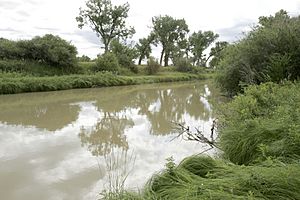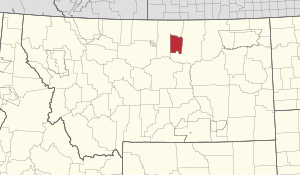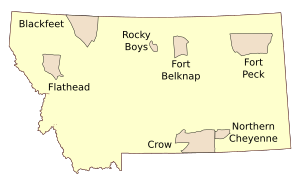Fort Belknap Indian Reservation facts for kids
Quick facts for kids
Fort Belknap Indian Reservation
|
||
|---|---|---|

River in Fort Belknap Indian Reservation
|
||
|
||

Location in Montana
|
||
| Tribes | Fort Belknap Indian Community: Assiniboine (Nakoda) Gros Ventre (Aaniiih) |
|
| Country | United States | |
| State | Montana | |
| Counties | Blaine Phillips |
|
| Established | June 1, 1888 | |
| Tribal Council | 1904 | |
| Headquarters | Fort Belknap Agency | |
| Government | ||
| • Body | Andrew Werk Jr. | |
| Area | ||
| • Total | 1,014.064 sq mi (2,626.41 km2) | |
| Population
(2017)
|
||
| • Total | 3,182 | |
| • Density | 3.1379/sq mi (1.21154/km2) | |
| Website | ftbelknap.org | |
The Fort Belknap Indian Reservation is a special homeland shared by two Native American tribes: the A'aninin (also known as Gros Ventre) and the Nakoda (also known as Assiniboine). The reservation covers about 1,014 square miles (2,626 square kilometers). It is located in north-central Montana, a state in the United States.
The main town and capital of the reservation is Fort Belknap Agency. It is located at the northern end of the reservation, near the city of Harlem, Montana, and the Milk River. In 2010, the tribes reported having 2,851 members.
In recent years, the tribes have worked to bring back bison to their lands. They also participate in a special program called the Land Buy-Back Program for Tribal Nations. This program helps to return land that was once divided among many owners back to the tribes.
Contents
History of Fort Belknap Reservation
The Fort Belknap Reservation was officially created in 1888. It is located in north-central Montana. This area is only a small part of the much larger traditional lands of the Blackfoot Confederacy. This group included the Piegan, Blood (Kainai), and Siksika (Black Foot) tribes, along with their allies, the Atsina or Aaniiih Nation (Gros Ventre).
Their original territory was huge, covering all of north-central and eastern Montana. It also included parts of eastern North Dakota. The reservation was named after William W. Belknap. He was the Secretary of War under President Ulysses S. Grant.
Early Treaties and Agreements
In October 1855, a peace agreement was signed near the Judith and Missouri Rivers. The Blackfoot Confederacy agreed to live peacefully with other Native American tribes and with people from the United States.
Before this, in 1851, the Nakoda Nation had signed the Treaty of Fort Laramie. They signed it with the United States government in what is now North Dakota. Other tribes like the Lakota, Dakota, Mandan, Arikara, Hidatsa, Cheyenne, and Arapaho also signed this treaty. These agreements helped to define the sacred territories of the tribes within the United States.
The Aaniiih People
The name Aaniiih means "White Clay People." It is believed they used white clay for ceremonies. Early French fur traders called them Gros Ventre, which means "big belly" in French. This name came from a misunderstanding. When communicating without a shared language, the Aaniiih used a hand sign for "waterfall." This sign looked like hands passing over the stomach. The French traders thought this meant "big belly." Other tribes called them the "Water Falls People."
The Nakoda People
The Nakoda, meaning "Generous Ones," separated from the Yanktonai Sioux in the 1600s. They moved west from the Minnesota woodlands to the northern plains. They were allies with the Plains Cree. The Chippewa people called the Nakoda "Assiniboine." This Ojibwe word means "one who cooks with stones." The Nakoda would heat rocks and put them into rawhide pots to cook food. Today, Nakoda people live on the Fort Belknap and Fort Peck Indian Reservations in Montana. They also live on several reserves in Canada, where they are known as Stoney.
Nomadic Life and Bison Hunting
Both the Aaniiih and Nakoda tribes were nomadic hunters and warriors. They followed the bison, often called buffalo, for their seasonal hunts. They used every part of the buffalo for food, clothing, tools, and shelter. Their food, clothes, and teepees all came from the buffalo. The buffalo was central to their way of life. It supported the nomadic cultures of the Nakoda, Aaniiih, and other Plains tribes. In the 1800s, the last wild herds of buffalo in the United States roamed in the Milk River valley of Montana.
Economy and Land Holdings
The Aaniiih and Nakoda tribes work together as one government. It is called the Fort Belknap Indian Community. They have built a community that respects its land, culture, and history. The name Fort Belknap comes from an old military and trading post on the Milk River. The town of Harlem, Montana, grew up about one mile northeast of this fort.
Land Buy-Back Program
For many years, land on the reservation was divided into small pieces among many owners. This happened after the Dawes Act of 1887. This act divided tribal lands into individual plots. The Fort Belknap Reservation has a lot of this "fractionated" land. About 75% of the land is owned by many different individuals.
The Land Buy-Back Program for Tribal Nations helps with this issue. It is part of a 2009 agreement from a lawsuit called Cobell v. Salazar. This program allows the government to buy back these small land portions from individual owners. Selling the land is completely voluntary. The land is bought at market value. When land is bought back, it is put into a federal trust. This means the tribe controls it. This helps the tribe manage its resources better for all members.
In 2015, over 3,500 offers were sent to landowners. Some offers were small, while others were very large. In June 2015, government employees visited the reservation. They discussed the program and reviewed offers worth up to $54 million. These offers covered 26,000 small pieces of land within the reservation. Margey Azure, who helps run the program, believes it helps both individuals and the tribe. She hopes it can help young tribal members start businesses like cattle ranching.
Bison and Grasslands Restoration
In March 2012, the Fort Belknap community received a herd of pure-bred plains bison from Yellowstone National Park. These bison were brought to the reservation after being gone from the area for about 100 years. The Fort Belknap Indian Community Grassland Restoration Project is a partnership between the reservation and the Bureau of Land Management. This project helps restore the grasslands for the bison and other wildlife.
In December 2021, 30 swift foxes were brought to the reserve from Colorado. Swift foxes had disappeared from the area 50 years before. This reintroduction helps bring back important animals to their natural habitat.
Communities on the Reservation
Notable Aaniiih People
- James Welch (1940 – 2003) was a famous author and poet. He wrote the novel Winter in the Blood, which was later made into a film.
- Bein Es Kanach (Red Whip) was a well-known chief.
- Theresa Lamebull (1896 – 2007) was believed to be the oldest living member of the A'aninin Tribe. She might have been the oldest Native American ever recorded.
- George Horse-Capture (1937 – 2013) was an anthropologist and author. He became a curator at the Plains Indian Museum and the National Museum of the American Indian.



